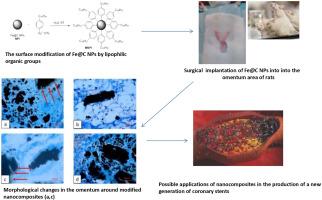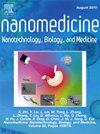利用化学修饰纳米复合材料对实验动物大网膜模型的动脉粥样硬化产生积极影响的概念原理。
IF 4.6
2区 医学
Q2 MEDICINE, RESEARCH & EXPERIMENTAL
Nanomedicine : nanotechnology, biology, and medicine
Pub Date : 2024-09-27
DOI:10.1016/j.nano.2024.102787
引用次数: 0
摘要
将化学修饰纳米复合材料用于动脉粥样硬化斑块可为研究其对改变斑块本身结构的影响提供新的机会。实验显示,在两组实验动物(大鼠,n = 30)的大网膜模型中,将尺寸为 10-30 Nm 的 Fe@C NPs 纳米复合材料植入大网膜区域。第 1 组(n = 15)的动物被植入化学改性的 Fe@C 纳米复合材料,第 2 组(n = 15)的动物被植入非改性的 Fe@C 纳米复合材料。1周、2周和3周后,我们使用两种针对脂肪组织的染料(尼罗蓝和苏丹Ⅲ)对网膜结构的变化进行了形态学研究。与未经改性的纳米颗粒相比,经化学改性的纳米复合材料已被证明可引起大网膜结构的形态学变化,并可能释放出类似的抗动脉粥样硬化因子。本文章由计算机程序翻译,如有差异,请以英文原文为准。

Conceptual rationale for the use of chemically modified nanocomposites for active influence on atherosclerosis using the greater omentum model of experimental animals
The use of chemically modified nanocomposites for atherosclerotic plaques can open up new opportunities for studying their effect on changing the structure of the plaque itself. It was shown on the model of the greater omentum of two groups of experimental animals (rats n = 30), which were implanted with Fe@C NPs nanocomposites of 10–30 Nm size into the omentum area. Group 1 (n = 15) consisted of animals that were implanted with chemically modified Fe@C NPs nanocomposites and control group 2 (n = 15) was with non-modified Fe@C NPs nanocomposites. After 1, 2 and 3 weeks we conducted the morphological study of changes in the structure of the omentum using two dyes (Nile Blue and Sudan III), which are specific for adipose tissue. Chemically modified nanocomposites have demonstrated, in contrast to non-modified nanoparticles, to cause morphological changes in the structure of the greater omentum accompanied by the probable release of a similar antiatherogenic factor.
求助全文
通过发布文献求助,成功后即可免费获取论文全文。
去求助
来源期刊
CiteScore
11.10
自引率
0.00%
发文量
133
审稿时长
42 days
期刊介绍:
The mission of Nanomedicine: Nanotechnology, Biology, and Medicine (Nanomedicine: NBM) is to promote the emerging interdisciplinary field of nanomedicine.
Nanomedicine: NBM is an international, peer-reviewed journal presenting novel, significant, and interdisciplinary theoretical and experimental results related to nanoscience and nanotechnology in the life and health sciences. Content includes basic, translational, and clinical research addressing diagnosis, treatment, monitoring, prediction, and prevention of diseases.

 求助内容:
求助内容: 应助结果提醒方式:
应助结果提醒方式:


